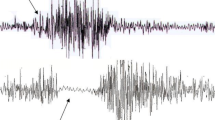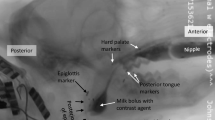Abstract
To determine risk factors for dysphagia after ventral rhizotomy, videofluoroscopic barium swallowing examinations were done on 41 spasmodic torticollis patients before and after surgery. Radiologic abnormalities were present in 68.3% of the patients before surgery, but these were only mildly abnormal in the majority. After surgery 95.1% showed radiologic abnormalities which were moderate or severe in one-third of the patients. Swallowing abnormalities correlated significantly with duration of torticollis and subjective complaints of swallowing difficulty both before and after surgery, but not with age, sex, or type of torticollis. The major acute postoperative finding was aggravation of preexisting pharyngeal dysfunction. Follow-up from about half of our original sample showed that gradual improvement occurred from 4 to 24 weeks after surgery by subjective report. We review the innervation of intrinsic and extrinsic pharyngeal musculature, and suggest that C1–3 rhizotomies and selective sectioning of the spinal accessory nerve are responsible for aggravation of pharyngeal swallowing dysfunction in the acute postsurgical period.
Similar content being viewed by others
References
Podivinsky F.: Torticollis. In Vinken PJ, Bruyn GW (eds):Handbook of Clinical Neurology, vol 6. Amsterdam: North-Holland, 1968, pp. 567–603.
Fahn S: The varied clinical expressions of dystonia.Neurol Clin 2:541–554, 1984.
Hedreen JC, Zweig RM, DeLong MR, Whitehouse PJ, Price DL: Primary dystonias: a review of the pathology and suggestions for new directions of study. In Fahn S (ed):Advances in Neurology, Vol 50: Dystonia 2 New York: Raven Press, 1988, pp 123–130
Gilroy J, Meyer JS: Disorders with involuntary movements.Medical Neurology, 2nd ed. New York: MacMillan, 1975, pp 187–188
Camella CL, Tanner CM, DeFoor-Hill L, Smith CS: Dysphagia after botulinum toxin injection treatment of spasmodic torticollis.Neurology 40 (Suppl 1):382, 1990 (Abstract)
Riski JE, Horner J, Nashold BS: Swallowing function in patients with spasmodic torticollis.Neurology 40:1443–1445, 1990.
Dandy WE: An operation for the treatment of spasmodic torticollis.Arch Surg 20:1021–1032, 1930
Logemann JA:Evaluation and Treatment of Swallowing Disorders. San Diego: College-Hill Press, 1983
Logemann JA:Manual for the Videofluorographic Study of Swallowing. San Diego: College-Hill Press, 1986
Siegel S:Nonparametric Statistics for the Behavioral Sciences. New York: McGraw-Hill, 1958, pp 104–111
Sorenson BF, Hamby WB: Spasmodic torticollis: results of 71 surgically treated cases.Neurology 16:867–878, 1966
Hamby WB, Schiffer S: Spasmodic torticollis: results after cervical rhizotomy in 50 cases.J Neurosurg 31:323–326, 1969
Logemann JA: Dysphagia in movement disorders. In Jankovic J, Tolosa E (eds).Advances in Neurology, Vol 49: Facial Dyskinesias. New York: Raven Press, 1988, pp 307–316.
Horner J, Massey EW, Riski JE, Lathrop DL, Chase KN: Aspiration following stroke: clinical correlates and outcome.Neurology 38:1359–1362, 1988.
Kakigi R, Shibasaki H, Kuroda Y, et al.: Meige's syndrome associated with spasmodic dysphagia.J Neurol Neurosurg Psychiatry 46, 589–590, 1983
Morrell RM: The neurology of swallowing. In Groher ME (ed):Dysphagia: Diagnosis and Management. Boston: Butterworths, 1984, pp 3–35
Netter FH: Nervous system: Part I. Anatomy and physiology. In Brass A (ed.):The CIBA Collection of Medical Illustrations. West Caldwell, NJ: CIBA Pharmaceutical, 1983, pp 105–109
Miller AJ: Neurophysiological basis of swallowing.Dysphagia 1:91–100, 1986
Bosma JF, Donner MW, Tanaka E, Robertson D: Anatomy of the pharynx, pertinent to swallowing.Dysphagia 1:23–33, 1986
Donner MW, Siegel CI: The evaluation of pharyngeal neuromuscular disorders by cinefluorography.AJR 94:299–307, 1965
Ekberg O, Nylander G: Cineradiography of the pharyngeal stage of deglutition in 250 patients with dysphagia.Br J Radiol 55:258–262, 1982
Groher ME:Dysphagia: Diagnosis and Management. Boston: Buterworths, 1984
Borgstrom PS, Ekberg O: Speed of peristalsis in pharyngeal constrictor musculature: correlation to age.Dysphagia 2:140–144, 1988
Bass NH: Neurogenic dysphagia: diagnostic assessment and rehabilitation of feeding disorders in the neurologically impaired. In Eisenberg MG, Grzesiak RC (eds):Adv Clin Rehabil 2:186–228, 1988
McConnell FMS: Analysis of pressure generation and bolus transit during pharyngeal swallowing,Laryngoscope 98:71–78, 1988
Tracy JF, Logemann JA, Kahrilas PJ, Jacob P, Kobara M, Krugler C: Preliminary observations on the effects of age on oropharyngeal deglutition.Dysphagia 4:90–94, 1989
Pontoppidan H, Beecher HK. Progressive loss of protective reflexes in the airway with the advance of age.JAMA 174: 2209–2213, 1960
Berg HM, Persky MS, Jacobs JB, Cohen NL: Cricopharyngeal myotomy: a review of surgical results in patients with cricopharyngeal achalasia of neurogenic origin.Laryngoscope 95:1337–1340, 1985
Logemann JA, Kahrilas PJ, Kobara M, Vakil NB: The benefit of head rotation on pharyngoesophageal dysphagia.Arch Phys Med Rehabil 70:292–296, 1989
Palmer ED: Disorders of the cricopharyngeus muscle: a review.Gastroenterology 71:510–519, 1976
Castell JA, Dalton CB, Castell DO: Effects of body position and bolus consistency on the manometric parameters and coordination of the upper esophageal sphincter and pharynx.Dysphagia 5:179–186, 1990
Author information
Authors and Affiliations
Rights and permissions
About this article
Cite this article
Horner, J., Riski, J.E., Ovelmen-Levitt, J. et al. Swallowing in torticollis before and after rhizotomy. Dysphagia 7, 117–125 (1992). https://doi.org/10.1007/BF02493443
Issue Date:
DOI: https://doi.org/10.1007/BF02493443




